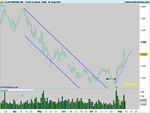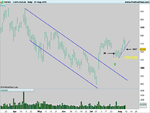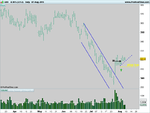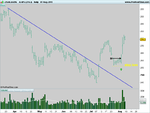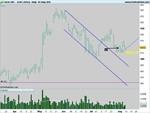About losses, posted elsewhere:
In your opinion, what trading worldview should a new trader have? I would assume this trading worldview would be somewhere in between the far left extreme ( any losses consume the trader with fear and such) and the far right where the trader is not remotely effected by any losses.
The implication is that the "trading worldview" centers around losses. It can at some point center around losses, depending on how the trader begins his journey. If he doesn't understand how markets work, if he does not have a thoroughly-tested and consistently-profitable trading plan, if he hasn't even thought about risk, much less accounted for it in his strategies and tactics, then, yes, quite soon he will be faced with losses. At that point, he can either become paralyzed by them, or he can ignore them until his broker notifies him that he no longer has enough in his account to trade.
The new trader should understand that the purpose of the market is to facilitate trade. He should understand that it functions according to the law of supply and demand. He should understand that the market is not sentient: it doesn't care about him, has no interest in what he wants or needs or what his personality is. It has no desire to make him happy nor to punish him. It has no desires at all.
Many if not most new traders -- and more than a few not-so-new traders -- will go to any lengths to avoid assuming responsibility for their trading and trades. This is why their trading plans, if any, are so "soft". Being soft, they do not lend themselves to the collection of data, and without data, the trader has no way of determining exactly what he is doing right and what he is doing wrong, much less what to do about either. If he conducts trading reviews at all, they tend to be of the self-congratulatory sort or a wallow in self-pity, neither of which helps him toward becoming a consistently successful trader.
Few new traders want to study the market. Those who read anything at all prefer to read what somebody says about the market rather than study the market itself. Few new traders are interested in practice, much less weeks to months of it. At the beginning, they generally succeed. They succeed because they have not yet learned fear. But the luck runs out sooner or later, and fear moves into the spare room and settles in for the duration. And the trader eventually becomes a statistic.
But this has all been said before by Jones, Seykota, Douglas, O'Neil, Gann, Gartley, Schabacker, Magee, Raschke, Schwartz, Oz, Zweig, and dozens of others. The message, however, is drowned out by Make Bazillions In Only Minutes A Day (at your kitchen table). And the beat goes on . . .
The trader who takes the other fork, though, studies the market. He learns why price goes up and down. He understands the scientific method and applies it to what he observes. He tests his hypotheses and begins to gather data in order to come up with a trading plan which is grounded in reality rather than wishes and hopes. He explores those strategies and tactics which enable him to act on what he has found as a result of his testing. He begins to understand that there is no such thing as a risk-free or loss-free method, but that his plan provides a level of predictability that provides a consistently profitable outcome over time. Not every trade. Over a series of trades. Over time. Therefore he does not freak out over losses but accepts them as part of the win-lose cycle*. They are a cost of doing business. Is he unaffected by them? Of course not. He analyzes them just as he analyzes his profitable trades so that he can maintain a course of continuing improvement.
And then he prepares for the following day . . .
*Before you’ve lost all your money, the thought that you haven’t the least idea what you’re doing may prevent you from blowing your account entirely. You realize now that this is not easy, it’s hard, it’s work, but rather than chuck it, you elect instead to take the subject “seriously”. You locate your library card and/or shop Amazon. You check out -- or take much of what you have left and buy -- all the “recommended reading”. You take the courses. You attend the seminars (box lunch included). You subscribe to the chatrooms and websites and newsletters. How-To book or notes in hand, you scan the markets every day. After a while (sometimes a good long while), you notice a particular phenomenon which pops up regularly and seems to "work" pretty well. You focus on this pattern. You begin to find more and more instances of it and all of them work! It’s all true! It Works! Your confidence in the pattern grows and you decide to take it the very next time it appears. You take it, and almost immediately your stop is hit, and you're underwater for the total amount of your stoploss.
So you back off and study this pattern further. You go back to the books, back to your notes. And the very next time it appears, it works. And again. And yet again. So you decide to try again. And you take the full hit on your stoploss.
Practically everyone goes through this, but few understand that this is all part of the win-lose cycle. They do not yet understand that loss is an inevitable part of any system/strategy/method/whathaveyou, that is, there is no such thing as a 100% win approach. When they gauge the success of a particular pattern or setup, they get caught up in the win cycle. They don't wait for the "lose" cycle to see how long it lasts or what the win/lose pattern is. Instead, they keep touching the pot and getting burned, never understanding that it's not the pot (pattern/setup) that's the problem, but a failure on their part to understand that it's the heat from the stove (the market) that they're paying no attention to whatsoever. So instead of trying to understand the nature of thermal transfer (the market), they avoid the pot (the pattern), moving on to another pattern/setup without bothering to find out whether or not the stove is on.




